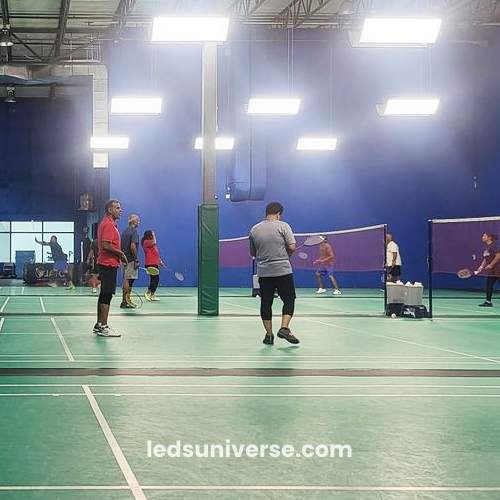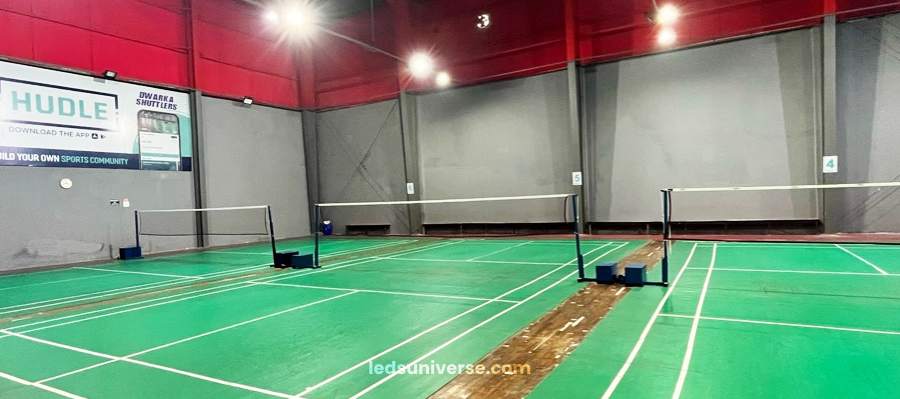LEDs are incredibly durable and long-lasting, meaning fewer replacements and lower maintenance costs for facilities. They also generate less heat, contributing to a more comfortable playing environment and reducing the risk of thermal damage to both the fixtures and the surrounding area.
Adequate lighting ensures that the entire court surface is evenly illuminated, reducing the likelihood of shadows and glare that can obstruct players’ vision. Shadows, for instance, can cause the shuttlecock to appear distorted or less distinct, making it challenging for players to judge its speed and trajectory accurately. Glare, on the other hand, can create discomfort and hinder players’ ability to focus, leading to decreased reaction times and less precise movements.
Reach out for free lighting consultation
Table of Contents
ToggleThe field of lighting technology has undergone a significant transformation, particularly in the realm of sports and recreational facilities. One of the most notable advancements in this evolution is the widespread adoption of LED (Light Emitting Diode) systems. LEDs have revolutionized badminton court lighting through their exceptional energy efficiency, durability, and superior performance.
LED lighting systems offer numerous benefits that are particularly advantageous for sports environments. One of the most prominent features of LEDs is their ability to provide consistent, high-quality illumination. Unlike traditional incandescent or fluorescent lighting, LEDs produce a bright, even light that enhances visibility across the entire court. This is crucial for badminton, where players need clear and uniform lighting to accurately track the fast-moving shuttlecock and execute precise shots.

Another advantage of LEDs is their superior durability. LEDs are designed to withstand harsh conditions and have a much longer lifespan compared to conventional lighting options. This means fewer replacements and less maintenance over time, which is beneficial for facilities looking to minimize operational costs. Additionally, LEDs generate less heat, reducing the risk of thermal damage to both the lighting fixtures and the surrounding environment.
The versatility of LED lighting is another benefit. Modern LED systems allow for adjustable brightness and color temperature, offering a level of customization that traditional lighting cannot match. For badminton courts, this means that the lighting can be tailored to meet specific requirements, such as the intensity needed for different times of day or varying levels of play. Facilities can adjust the lighting to create the ideal conditions for both practice and competitive play, enhancing the overall player experience.
LED lights also offer superior color rendering, which is essential for accurately distinguishing the shuttlecock from the court surface. High Color Rendering Index (CRI) LEDs provide vibrant and true-to-life colors, ensuring that players have the best possible visibility and can react quickly to changes in the game’s dynamics.
The integration of smart lighting solutions represents another significant innovation in badminton court lighting. Smart lighting systems leverage advanced technology to offer dynamic and responsive lighting control, adapting to real-time conditions and user preferences.
One of the features of smart lighting systems is their ability to use sensors and automated controls to adjust lighting levels based on various factors. For example, these systems can automatically dim or brighten the lights depending on the time of day, the number of players on the court, or the ambient light levels in the facility. This adaptive functionality ensures that the lighting remains optimal at all times, enhancing the playing experience and improving overall visibility.
In addition to enhancing player comfort, smart lighting solutions contribute to energy efficiency and cost savings. By adjusting lighting levels according to actual needs, these systems reduce energy consumption and lower utility bills. For instance, the lights can be dimmed during off-peak hours or when fewer players are on the court, leading to significant savings over time.
Smart lighting systems also offer the convenience of remote control and monitoring. Facility managers can integrate these systems with mobile apps and centralized control platforms, allowing them to adjust lighting settings from anywhere. This remote access simplifies the management of lighting conditions, making it easier to respond to changes and maintain optimal lighting for different activities and events.
Moreover, smart lighting solutions often include features such as programmable schedules and scene settings. Facility managers can create custom lighting scenarios for different types of events or training sessions, ensuring that the lighting meets the specific needs of each situation. This level of control enhances flexibility and ensures that the lighting contributes effectively to the overall functionality of the badminton court.
In a sport where precision and quick reflexes are crucial, inconsistent lighting can disrupt players’ focus and hinder their ability to perform at their best. Uneven illumination can lead to areas of the court being too bright while others are inadequately lit, creating shadows and glare that interfere with players’ vision.
The goal of achieving uniform illumination is to ensure that every part of the court is evenly lit, eliminating dark spots and minimizing visual distractions. This is essential for maintaining consistent visibility across the entire playing surface. Uniform lighting helps players track the shuttlecock more accurately, judge distances better, and execute their shots with greater precision.
Uniformity is typically measured in lux, which quantifies the amount of light falling on a given area. For badminton courts, the recommended illumination levels generally range from 300 to 500 lux. This range is suitable for different levels of play, from casual recreational games to intense professional competitions. The specific lux level required may vary depending on the size of the court, the type of activities being conducted, and the presence of natural light sources. Ensuring that the illumination meets these standards helps provide a consistent playing environment that supports players’ performance and comfort.
Achieving uniform illumination requires careful consideration of the placement and design of lighting fixtures. Strategic positioning of lights, coupled with the use of high-quality fixtures that distribute light evenly, is essential for eliminating shadows and ensuring that every area of the court is well-lit. Modern lighting solutions often include advanced optics and reflector designs to achieve this level of uniformity.

Color temperature is another aspect of badminton court lighting. It refers to the warmth or coolness of the light emitted by the fixtures, measured in Kelvin (K). For badminton courts, a color temperature of approximately 4000K to 5000K is considered ideal. This range provides a neutral white light that closely resembles natural daylight.
The choice of color temperature affects how players perceive colors and details on the court. A neutral white light with a color temperature within this range enhances contrast and visibility, making it easier for players to track the shuttlecock and maintain focus. This is particularly important given the fast-moving nature of the sport and the need for accurate visual information to make split-second decisions.
In addition to color temperature, glare reduction is crucial for creating a comfortable and effective playing environment. Glare occurs when excessive brightness causes discomfort or impairs vision. In badminton, glare can result from direct light sources or reflections from shiny surfaces. It can lead to eye strain and hinder players’ ability to see the shuttlecock clearly.
To address glare, modern lighting solutions often incorporate features such as anti-glare coatings and diffusers. Anti-glare coatings help to minimize direct glare from light sources, while diffusers spread light more evenly and reduce harsh reflections. By incorporating these features, lighting systems can create a more comfortable visual environment that reduces eye strain and enhances overall playing conditions.
Effective glare reduction not only improves player comfort but also contributes to a more enjoyable and productive game. Players can focus better on their performance without being distracted or hindered by uncomfortable lighting conditions. Additionally, proper glare control helps maintain a professional standard of play, ensuring that lighting does not become a limiting factor in competitive settings.
| Benefit | Description |
|---|---|
| Enhanced Player Performance | Proper lighting improves player performance by ensuring clear visibility of the shuttlecock, accurate distance judgment, and swift reactions. It also reduces visual fatigue and enhances concentration. |
| Safety and Injury Prevention | Adequate lighting helps identify hazards and obstacles, reducing the risk of accidents and injuries. It also improves navigation around the court, making it safer for players. |
| Energy Efficiency and Cost Savings | Energy-efficient lighting solutions, such as LEDs, lower electricity bills and reduce maintenance costs due to their longer lifespan. Smart lighting systems further optimize energy use based on real-time needs. |
Proper lighting impacts player performance. Adequate illumination ensures that players can clearly see the shuttlecock, judge distances accurately, and react swiftly to their opponents’ shots. This is particularly important in competitive settings where split-second decisions can determine the outcome of a match. Well-lit courts also help in reducing visual fatigue and improving overall concentration, allowing players to perform at their best.
Safety is another benefit of proper badminton court lighting. Adequate lighting helps in identifying hazards and obstacles, such as uneven court surfaces or stray equipment, reducing the risk of accidents and injuries. Well-lit courts also make it easier for players to navigate the court, minimizing the chances of collisions and falls. In recreational settings, good lighting ensures a safe environment for players of all ages and skill levels.
Incorporating energy-efficient lighting solutions, such as LEDs, not only benefits players but also offers cost savings for facility managers. LED lights consume significantly less energy compared to traditional incandescent or fluorescent bulbs, resulting in lower electricity bills. Additionally, LEDs have a longer lifespan, reducing the frequency and cost of maintenance and replacements. Smart lighting systems further enhance energy efficiency by optimizing lighting levels based on real-time needs.
The placement and design of lighting fixtures achieve optimal illumination. For badminton courts, fixtures should be strategically positioned to ensure even coverage and minimize shadows. Overhead lighting is commonly used, with fixtures installed around the perimeter of the court or mounted on the ceiling. The design of the fixtures should also include features that reduce glare and distribute light uniformly across the court surface.
The lighting system should complement the court’s layout and architectural features while ensuring that all areas are adequately illuminated. Consideration of the court’s dimensions, ceiling height, and any potential obstructions will help in selecting the appropriate lighting fixtures and placement. Additionally, incorporating lighting into the design can enhance the visual appeal of the court and create an inviting atmosphere for players and spectators.
Routine inspections help in identifying any issues, such as flickering lights or damaged fixtures, before they impact the court’s functionality. Cleaning the fixtures and lenses periodically prevents the buildup of dust and debris, which can reduce light output and affect visibility. Adhering to a maintenance schedule will help in prolonging the lifespan of the lighting system and ensuring consistent performance.
Technology advancements may necessitate occasional upgrades or replacements of lighting fixtures. Staying informed about the latest innovations and evaluating the performance of existing systems can guide decisions on when to invest in new lighting solutions. Upgrading to more efficient and advanced technologies can provide long-term benefits, including improved illumination, energy savings, and enhanced player experience.
The advancements in lighting technology, including LED systems and smart solutions, have greatly enhanced the quality and functionality of lighting for badminton courts. By focusing on key lighting concepts such as uniformity, color temperature, and glare reduction, and considering design and maintenance factors, facilities can provide an exceptional playing environment that meets the needs of both recreational and professional players. Investing in high-quality lighting solutions not only improves the game but also contributes to the overall enjoyment and safety of the sport.